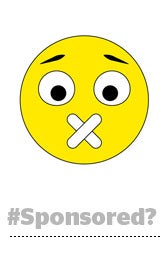Thirty-seven percent of publishers fail to properly label their sponsored content to comply with the FTC enforcement policy issued in December 2015, according to MediaRadar. The ad sales intelligence firm scanned sponsored content ads from 12,000 brands over the course of 2016.
The numbers may look bad, but they actually represent progress. When the FTC released the native ad guidance at the end of 2015, MediaRadar found that 71% of publishers didn’t comply. Over the past year, the majority have taken steps to fall in line with the consumer watchdog agency’s guidelines. As for the rest?
“There is a group of people unaware that the law exists, or that doesn’t care,” said MediaRadar CEO Todd Krizelman. He noted that the comScore 100 and large sponsored content publishers like Forbes, Quartz and The New York Times all comply with the FTC guidance. Smaller publishers tend to be more lax about compliance.
Publishers can miss guidelines in a number of ways. The worst offense, no labeling at all, declined precipitously. Only 5% of publishers provided no labeling of sponsored content. Last year, shortly after the FTC-issued guidance, 25% of publishers didn’t label sponsored content at all.
The majority, 74%, now label content “sponsored,” and 11% use “promoted.” The FTC approves of “sponsored content” but not “sponsored by” or “promoted,” both terms it feels are misleading. And 32% of publishers apply sponsorship labels to the bottom of posts, while the FTC prefers the top.
But the publishers skirting compliance may not be the ones with the most to lose. The FTC said when issuing the guidelines that it considers the advertiser to be the primary party responsible for labeling sponsored posts correctly, though it would take into account others.
“The brands should know better,” Krizelman said. “We don’t see errors with big firms like P&G or Unilever, but we do see large national brands that are buying ads that aren’t properly noted.”
The FTC has taken action before. In March 2016, it settled charges with Lord & Taylor for not labeling sponsored posts on the publisher Nylon’s Instagram page. And another 50 fashion influencers posted shots of themselves wearing the dress without a “#sponsored” hashtag.
A few months later, the FTC settled with Warner Bros. for a similar violation in which influencers, like PewDiePie, didn’t disclose sponsorships after they were paid to promote videos.
Brands and publishers executing native campaigns are often quite new to the format.
MediaRadar tracked 610 new advertisers each month buying native. And the amount of publishers offering native tripled over the past two years, Krizelman said. If they aren’t doing research before launching campaigns, that lack of foresight could be contributing to missing sponsored content labeling.
Although MediaRadar saw 63% of publishers modify their sponsored content programs last year, Krizelman doesn’t expect more publishers to fall in line when they repeat the study next year.
“We think the most responsible custodians have already acted,” he said. “Unless the FTC communicates more or enforces more, I wouldn’t expect to see much change. That’s my own expectation of how human behavior works.”














